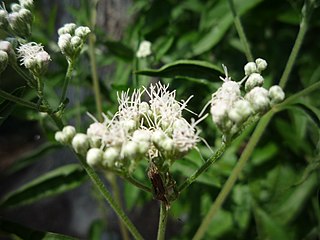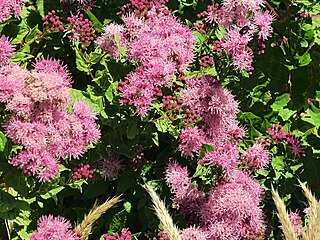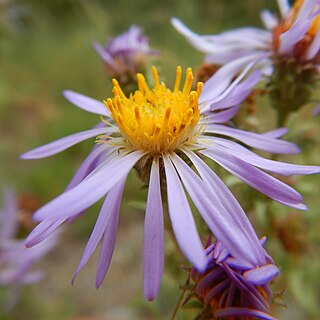
Eupatorium altissimum, with the common names tall thoroughwort and tall boneset, is a perennial herbaceous plant in the Asteraceae family with a native range including much of the eastern and central United States and Canada. It is a tall plant found in open woods, prairies, fields, and waste areas, with white flowers that bloom in the late summer and fall.

Eupatorium serotinum, also known as late boneset or late thoroughwort, is a fall-blooming, perennial, herbaceous plant native to North America.

Eupatorium hyssopifolium, also known as hyssopleaf thoroughwort, is a fall-blooming herbaceous plant native to North America. Like other members of the genus Eupatorium it has inflorescences containing a large number of very small flower heads, each with 5 white disc florets but no ray florets. At 0.5 to one meter tall, it is towards the shorter end of the range of heights found in Eupatorium species.

Eupatorium album, or white thoroughwort, is a herbaceous perennial plant in the family Asteraceae native from the eastern and southern United States, from eastern Texas to Connecticut, inland as far as Indiana.
Eupatorium compositifolium, commonly called yankeeweed and coastal dog fennel, is a North American herbaceous perennial plant in the family Asteraceae native to the southern United States. Like other members of the genus Eupatorium it has inflorescences containing a large number of small, white flower heads, each with 5 disc florets but no ray florets. The plant is 0.5 to 2 meters tall. Flowers bloom August to October. Its habitats include sand dunes, disturbed areas, and flat-woods.

Eupatorium mikanioides, commonly called semaphore thoroughwort, is a herbaceous perennial plant in the family Asteraceae found only in the US state of Florida.

Eupatorium mohrii, commonly called Mohr's thoroughwort, is a herbaceous perennial plant in the family Asteraceae native to the southeastern and south-central states of the United States, in the coastal plain from Virginia to Texas. It has also been found in the Dominican Republic.

Eupatorium resinosum, the pine barren thoroughwort, is a rare North American plant species in the family Asteraceae.
Eupatorium semiserratum, commonly called smallflower thoroughwort, is a North American plant species in the family Asteraceae. It is native to the southeastern and south-central United States, found in all the coastal states from Maryland to Texas and inland as far as Missouri and Kentucky.

Eupatorium sessilifolium, commonly called upland boneset or sessile-leaved boneset, is a North American plant species in the family Asteraceae. It is native to the eastern and central United States, found from Maine south to North Carolina and Alabama, and west as far as Arkansas, Kansas, and Minnesota.

Ageratina occidentalis is a species of flowering plant in the family Asteraceae known by the common name western snakeroot or western eupatorium. It is native to the western United States where it grows in several types of habitat. It is found in California, Oregon, Washington, Idaho, Montana, Nevada, and Utah.

Symphyotrichum sericeum is a species of flowering plant in the family Asteraceae native to central North America. Commonly known as western silver aster, western silvery aster, and silky aster, it is a perennial, herbaceous plant that may reach 70 centimeters tall. Its flowers have purple ray florets and pink then purple disk florets, and its leaves are firm and silvery-green.

Symphyotrichum campestre is a species of flowering plant of the family Asteraceae commonly known as western meadow aster. It is native to much of western North America where it grows in many habitats, generally at some elevation.

Symphyotrichum frondosum is a species of flowering plant in the family Asteraceae native to western North America. Commonly known as short-rayed alkali aster, it is an annual or perennial herbaceous plant that may reach 140 centimeters tall.

Ageratina luciae-brauniae is a species of flowering plant in the family Asteraceae known by the common names Lucy Braun's snakeroot and rockhouse white snakeroot. It is native to the eastern United States, where it is limited to the Cumberland Plateau of Kentucky and Tennessee. It may also occur in South Carolina but these reports are unconfirmed.

Symphyotrichum prenanthoides is a species of flowering plant in the family Asteraceae known by the common name crookedstem aster. It is native to northcentral and northeastern North America.

Balduina atropurpurea, the purpledisk honeycombhead, is a North American species of plants in the sunflower family. It is native to the southeastern United States.
Chromolaena bigelovii called Bigelow's false thoroughwort, or Bigelow's thoroughwort, is a North American species of flowering shrub in the family Asteraceae. It is native to northeastern Mexico and the US State of Texas.

Symphyotrichum porteri is a species of flowering plant in the family Asteraceae endemic to the foothills of the Rocky Mountains in the U.S. states of Wyoming, Colorado, and New Mexico. Commonly known as Porter's aster, it is a perennial, herbaceous plant that may reach 10 to 50 centimeters tall. Its flowers have white, rarely pinkish, ray florets and yellow, becoming pink then brown, disk florets. S. porteri grows at elevations of 1,800–2,900 meters. Its limited range makes it a NatureServe Vulnerable (G3) species, and it is classified Critically Imperiled (S1) in Wyoming.

Symphyotrichum retroflexum is a species of flowering plant in the family Asteraceae native to the southeastern United States. Commonly known as rigid whitetop aster, it is a perennial, herbaceous plant that may reach 40 to 100 centimeters tall. Its flowers have blue to purple ray florets and cream to pale yellow then pinkish disk florets. It is known only from the Blue Ridge Mountains in Alabama, Georgia, North Carolina, South Carolina, Tennessee, and Virginia, where it grows in wooded areas at elevations of 400–1,500 meters. As of September 2021, NatureServe classified it as Apparently Secure (G4); it had been reviewed last in 1994 and is marked as "needs review". There is an introduced presence of S. retroflexum in southeast China.

















